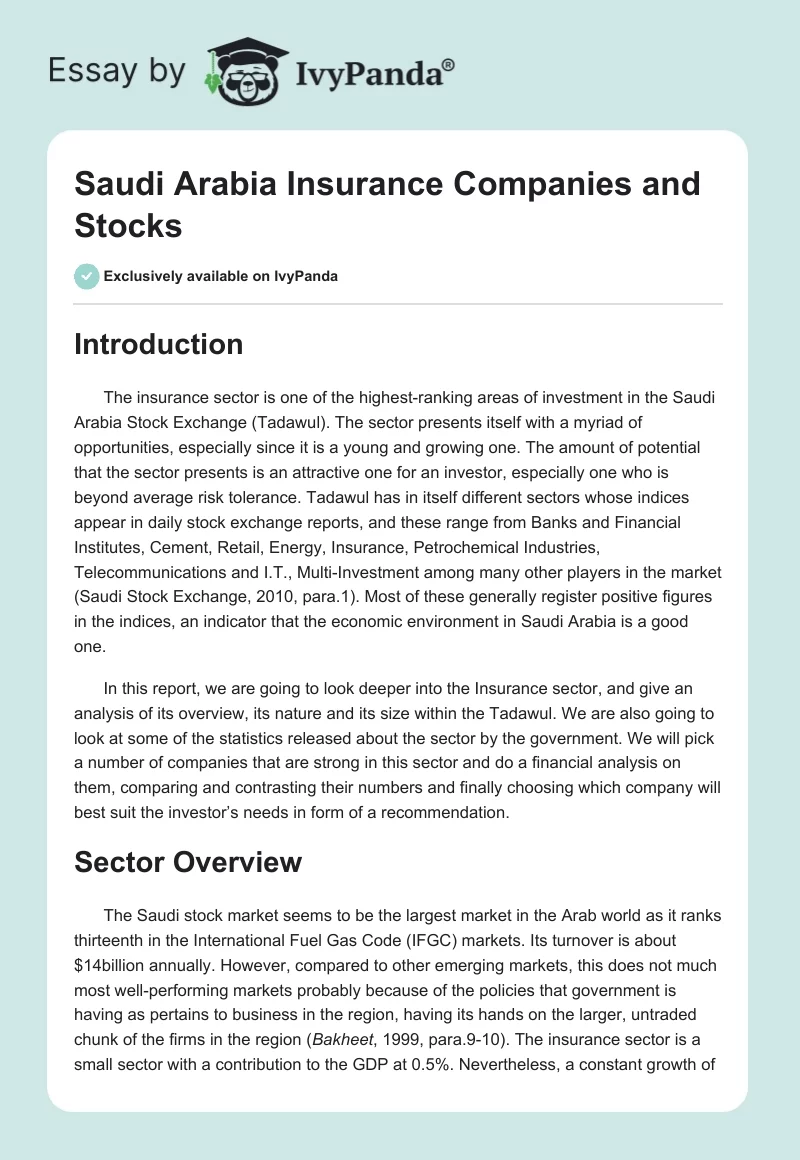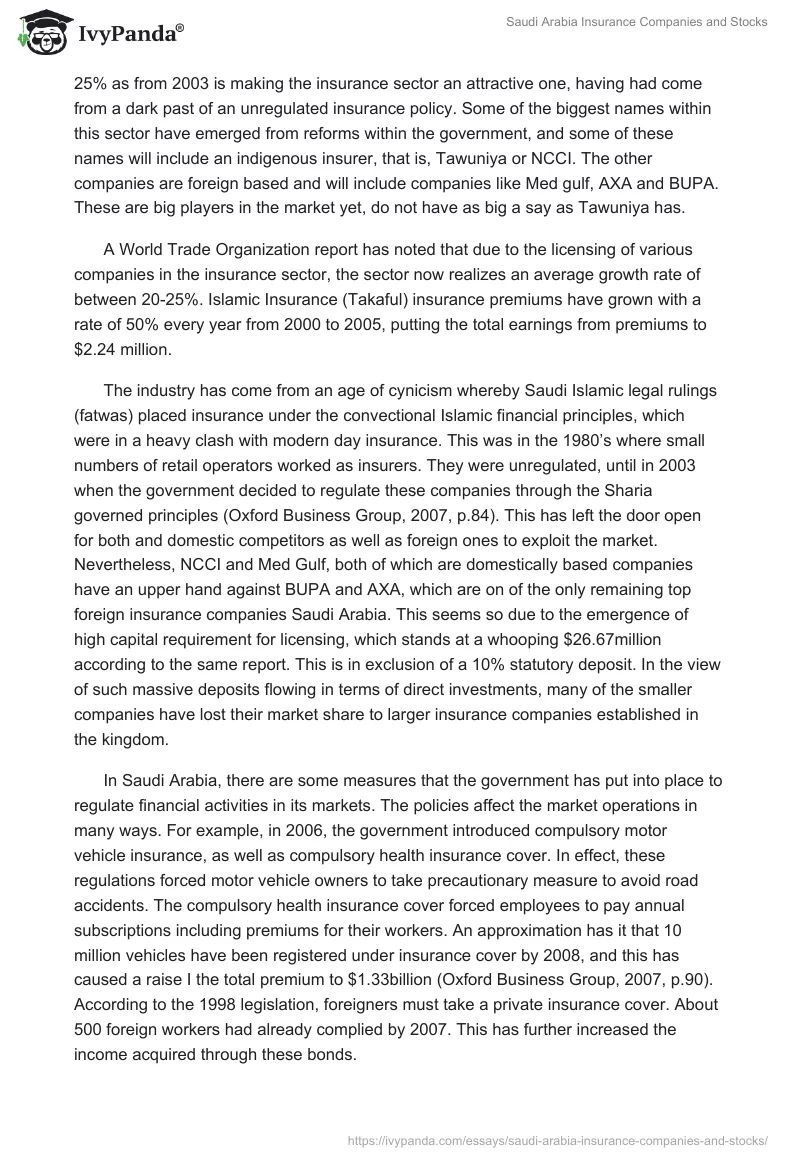Introduction
The insurance sector is one of the highest-ranking areas of investment in the Saudi Arabia Stock Exchange (Tadawul). The sector presents itself with a myriad of opportunities, especially since it is a young and growing one. The amount of potential that the sector presents is an attractive one for an investor, especially one who is beyond average risk tolerance. Tadawul has in itself different sectors whose indices appear in daily stock exchange reports, and these range from Banks and Financial Institutes, Cement, Retail, Energy, Insurance, Petrochemical Industries, Telecommunications and I.T., Multi-Investment among many other players in the market (Saudi Stock Exchange, 2010, para.1). Most of these generally register positive figures in the indices, an indicator that the economic environment in Saudi Arabia is a good one.
In this report, we are going to look deeper into the Insurance sector, and give an analysis of its overview, its nature and its size within the Tadawul. We are also going to look at some of the statistics released about the sector by the government. We will pick a number of companies that are strong in this sector and do a financial analysis on them, comparing and contrasting their numbers and finally choosing which company will best suit the investor’s needs in form of a recommendation.
Sector Overview
The Saudi stock market seems to be the largest market in the Arab world as it ranks thirteenth in the International Fuel Gas Code (IFGC) markets. Its turnover is about $14billion annually. However, compared to other emerging markets, this does not much most well-performing markets probably because of the policies that government is having as pertains to business in the region, having its hands on the larger, untraded chunk of the firms in the region (Bakheet, 1999, para.9-10). The insurance sector is a small sector with a contribution to the GDP at 0.5%. Nevertheless, a constant growth of 25% as from 2003 is making the insurance sector an attractive one, having had come from a dark past of an unregulated insurance policy. Some of the biggest names within this sector have emerged from reforms within the government, and some of these names will include an indigenous insurer, that is, Tawuniya or NCCI. The other companies are foreign based and will include companies like Med gulf, AXA and BUPA. These are big players in the market yet, do not have as big a say as Tawuniya has.
A World Trade Organization report has noted that due to the licensing of various companies in the insurance sector, the sector now realizes an average growth rate of between 20-25%. Islamic Insurance (Takaful) insurance premiums have grown with a rate of 50% every year from 2000 to 2005, putting the total earnings from premiums to $2.24 million.
The industry has come from an age of cynicism whereby Saudi Islamic legal rulings (fatwas) placed insurance under the convectional Islamic financial principles, which were in a heavy clash with modern day insurance. This was in the 1980’s where small numbers of retail operators worked as insurers. They were unregulated, until in 2003 when the government decided to regulate these companies through the Sharia governed principles (Oxford Business Group, 2007, p.84). This has left the door open for both and domestic competitors as well as foreign ones to exploit the market. Nevertheless, NCCI and Med Gulf, both of which are domestically based companies have an upper hand against BUPA and AXA, which are on of the only remaining top foreign insurance companies Saudi Arabia. This seems so due to the emergence of high capital requirement for licensing, which stands at a whooping $26.67million according to the same report. This is in exclusion of a 10% statutory deposit. In the view of such massive deposits flowing in terms of direct investments, many of the smaller companies have lost their market share to larger insurance companies established in the kingdom.
In Saudi Arabia, there are some measures that the government has put into place to regulate financial activities in its markets. The policies affect the market operations in many ways. For example, in 2006, the government introduced compulsory motor vehicle insurance, as well as compulsory health insurance cover. In effect, these regulations forced motor vehicle owners to take precautionary measure to avoid road accidents. The compulsory health insurance cover forced employees to pay annual subscriptions including premiums for their workers. An approximation has it that 10 million vehicles have been registered under insurance cover by 2008, and this has caused a raise I the total premium to $1.33billion (Oxford Business Group, 2007, p.90). According to the 1998 legislation, foreigners must take a private insurance cover. About 500 foreign workers had already complied by 2007. This has further increased the income acquired through these bonds.
Stock Selection and Financial Analysis
In this segment, we shall compare some of the big companies in the insurance market, and assess the capitalization ratios of the five top companies that are in the insurance sector. We are going to look into the history of the companies involved and therefore make an analysis on the potential growth, that the company has, gauging whether the company’s future is bright or whether it is deteriorating, or even whether stagnating. In doing so, we are going to settle on one company, which is worth investing in.
NCCI
The NCCI is a group of companies that form a Non Governmental Organization, which is the main domestic structure in the insurance business. It continues to dominate this market, although in 2003 the Institute of Banking (IOB) declined from publishing further reports about the group of companies. Conversely, gross premiums for the firm amplify at 16% in 2006. Entire revenues rose at the same time by 6% from sr 1,218 million to sr 1,289 million. There was a 6% payment of gross claims in the year 2006. The liquidity ratios for the year 2005 were quite promising. Considering the year 2003, its gross premiums rose by 43%, with a premium retention rate of 55.6% in the year 2004. This put NCCI at a good financial position to deal with risks in financial constraints. During the period from 2001 to 2004, the company recorded the following ratios.
Projected return ratios for NCCI between 2004 and 2009:
Med Gulf
The company currently ranks third in Saudi Arabia, as it possesses capital worth SR2.62billion. Its shares jumped 167.50% after opening at SR42. 1.5 million Saudi’s took part in purchasing its shares which are worth RS200 million, with the National Bank being named the biggest shareholders. As at 2005, the premiums in MedGulf grew by 84% according to an annual report released by the company. The total investments for the company reached sr 803 million, though this was a decrease compared to year 2005. Net income from the shareholders’ operations increased at 50%. There was a recorded increase in the company’s total asset form SR4164 to SR 4252 millions. This provide a good financial base for expansion of operations.
BUPA
BUPA is one of the biggest internationally based insurance companies that have spread its wings even to Saudi Arabia. Foreign policy in Saudi has not really affected the working environment in the area and therefore it has been relatively easy for BUPA t operates in this region. Its capitalization in the region is currently lying at $106.6 million. BUPA provides health cover for 11000 employees in Saudi Arabia, as it closed in a contract to serve in the health sector as at 2006. During the year 2007 and 2008, BUPA recorded the following figures for cash flow financing:
AXA Cooperative Insurance
AXA is another of the top five insurance companies in this region and is a new player, which recently secured large contracts with other industries like the energy and telecommunications industry. The mighty that AXA reveals is in its capacity to pay asserts. Over $15 million, worth of the same amount went into people’s claims over a period of 12 months. Its capitalization lies at $95.24 million and is well on its way to being one of the top most insurance companies Saudi Arabia has seen yet. As it stands, AXA is recording a growth rate of 14% annually.
The value of the top companies in insurance indicates in the above short analysis. All these companies contain their shortcomings yet all of tem have their own strengths. It is interesting to note that different insurance companies aim at different goals, depicted from the analysis for AXA. It is rather a small insurance company yet it ranks first in making sure that most of the claims subscribed to insurance cover met appropriate pay on due time.
Some of the companies like BUPA take specific contract to provide health insurance for employees on behalf of companies. The move for AXA to sign in contracts with the telecommunications industry is a move that will find the company specialized in a certain insurance field, or if not, will be having a greater influence than other insurance companies in that particular field. for AXA, the ratios for the year 2007/8/9 were as follows.
Expense ratio:
- 2007-12.3%,
- 2008-13.2%,
- 2009-15.0%
Recommendation
As the NCCI is the leading company in terms of numbers in the insurance company’s stocks, I would advice any investor to try this company. From our findings of the company in the Arabian Stock market, analysis of the company shows that its stability may likely continue into the next decade. NCCI will probably remain to be the market leader. The analysis reflected its customer confidence with the products and this in turn promoted the confidence of investors to buy big stakes in the company. With a trading of SR151 per share there would be a chance to gain something from investment in this company. Besides, the NCCI has a wide range of scope for its consumers, from medical cover, to energy, to the aviation industry, to engineering and the property industry. This scope gives the company a wider consumer base, meaning that its value appreciates in terms of capital.
The company shows strong management and a very competitive position in the stocks. This appears vividly by the amount of premiums that are sold and the amount of trading in its shares that the company does. Capitalization is quite strong and this increases the company’s ability to remain on top of the charts.
The only disadvantage in going for such a company as NCCI is that it will be very hard to find one of its shares in the market. IPO’s for this kind of companies are almost impossible to obtain unless one will wait for a particular opening in order to make a bid. This though is the case for all the companies that I have mentioned, since all these companies are big ones, recording significant growth in their markets. This logistic therefore gives a level playing field amongst all companies that one would consider to invest in. A bid of SR180 per share would be a good start for bidding. It will be hard though to estimate target price owing to be market vibrant. It would be better to take the prices that the market forces of demand and supply creates.
Reference List
Arab News, (2006). Saudi NCCI Ratings Raised to ‘A’; Outlook Stable. Gulf base. Web.
Bakheet, Beshr. (1999). Developing GCC Stock Markets: The Private Sector Role. Middle East Policy Council. Web.
Oxford Business Group. (2007). Islamic Insurance-Takaful. The report: Emerging Saudi Arabia. Oxford: Oxford Business Group.
Saudi Stock Exchange.(2010). General Information. Web.


